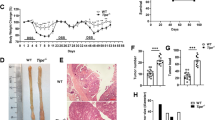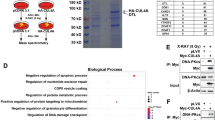Abstract
Ku70, a known nonhomologous end-joining (NHEJ) factor, also functions in tumor suppression, although this molecular mechanism remains uncharacterized. Previously, we showed that mice deficient for DNA ligase IV (Lig4), another key NHEJ factor, succumbed to aggressive lymphoma in the absence of tumor suppressor p53. However, the tumor phenotype is abrogated by the introduction of a hypomorphic mutant p53R172P, which impaired p53-mediated apoptosis but not cell-cycle arrest. However, Lig4−/−p53R172P mice succumbed to severe diabetes. To further elucidate the role of NHEJ and p53-mediated apoptosis in vivo, we bred Ku70−/− p53R172P mice. Unexpectedly, these mice were free of diabetes, although 80% of the mutant mice had abnormally enlarged colons with pronounced inflammation. Remarkably, most of these mutant mice progressed to dysplasia, adenoma and adenocarcinoma; this is in contrast to the Lig4−/−p53R172P phenotype, strongly suggesting an NHEJ-independent function of Ku70. Significantly, our analyses of Ku70−/−p53R172P colonic epithelial cells show nuclear stabilization of β-catenin accompanied by higher expression of cyclin D1 and c-Myc in affected colon sections than in control samples. This is not due to the p53 mutation, as Ku70−/− mice share this phenotype. Our results not only unravel a novel function of Ku70 essential for colon homeostasis, but also establish an excellent in vivo model in which to study how chronic inflammation and abnormal cellular proliferation underlie tumorigenesis and tumor progression in the colon.
This is a preview of subscription content, access via your institution
Access options
Subscribe to this journal
Receive 50 print issues and online access
$259.00 per year
only $5.18 per issue
Buy this article
- Purchase on Springer Link
- Instant access to full article PDF
Prices may be subject to local taxes which are calculated during checkout





Similar content being viewed by others
References
Jemal A, Siegel R, Xu J, Ward E . Cancer statistics, 2010. CA Cancer J Clin 2010; 60: 277–300.
Lao VV, Grady WM . Epigenetics and colorectal cancer. Nat Rev Gastroenterol Hepatol 2011; 8: 686–700.
Saif MW, Chu E . Biology of colorectal cancer. Cancer J 2010; 16: 196–201.
Fearnhead NS, Wilding JL, Bodmer WF . Genetics of colorectal cancer: hereditary aspects and overview of colorectal tumorigenesis. Br Med Bull 2002; 64: 27–43.
Terzic J, Grivennikov S, Karin E, Karin M . Inflammation and colon cancer. Gastroenterology 2010; 138: e2105.
Westbrook AM, Szakmary A, Schiestl RH . Mechanisms of intestinal inflammation and development of associated cancers: lessons learned from mouse models. Mutat Res 2010; 705: 40–59.
Zaanan A, Meunier K, Sangar F, Flejou JF, Praz F . Microsatellite instability in colorectal cancer: from molecular oncogenic mechanisms to clinical implications. Cell Oncol (Dordr) 2011; 34: 155–176.
Mahaney BL, Meek K, Lees-Miller SP . Repair of ionizing radiation-induced DNA double-strand breaks by non-homologous end-joining. Biochem J 2009; 417: 639–650.
Weterings E, Chen DJ . The endless tale of non-homologous end-joining. Cell Res 2008; 18: 114–124.
Walker JR, Corpina RA, Goldberg J . Structure of the Ku heterodimer bound to DNA and its implications for double-strand break repair. Nature 2001; 412: 607–614.
Gottlieb TM, Jackson SP . The DNA-dependent protein kinase: requirement for DNA ends and association with Ku antigen. Cell 1993; 72: 131–142.
Ma Y, Pannicke U, Schwarz K, Lieber MR . Hairpin opening and overhang processing by an Artemis/DNA-dependent protein kinase complex in nonhomologous end joining and V(D)J recombination. Cell 2002; 108: 781–794.
Sekiguchi JM, Ferguson DO . DNA double-strand break repair: a relentless hunt uncovers new prey. Cell 2006; 124: 260–262.
Frank KM, Sekiguchi JM, Seidl KJ, Swat W, Rathbun GA, Cheng HL et al. Late embryonic lethality and impaired V(D)J recombination in mice lacking DNA ligase IV. Nature 1998; 396: 173–177.
Gao Y, Sun Y, Frank KM, Dikkes P, Fujiwara Y, Seidl KJ et al. A critical role for DNA end-joining proteins in both lymphogenesis and neurogenesis. Cell 1998; 95: 891–902.
Gao Y, Ferguson DO, Xie W, Manis JP, Sekiguchi J, Frank KM et al. Interplay of p53 and DNA-repair protein XRCC4 in tumorigenesis, genomic stability and development. Nature 2000; 404: 897–900.
Bassing CH, Alt FW . The cellular response to general and programmed DNA double strand breaks. DNA repair (Amst) 2004; 3: 781–796.
Puebla-Osorio N, Zhu C . DNA damage and repair during lymphoid development: antigen receptor diversity, genomic integrity and lymphomagenesis. Immunol Res 2008; 41: 103–122.
Difilippantonio MJ, Petersen S, Chen HT, Johnson R, Jasin M, Kanaar R et al. Evidence for replicative repair of DNA double-strand breaks leading to oncogenic translocation and gene amplification. J Exp Med 2002; 196: 469–480.
Zhu C, Mills KD, Ferguson DO, Lee C, Manis J, Fleming J et al. Unrepaired DNA breaks in p53-deficient cells lead to oncogenic gene amplification subsequent to translocations. Cell 2002; 109: 811–821.
Liu G, Parant JM, Lang G, Chau P, Chavez-Reyes A, El-Naggar AK et al. Chromosome stability, in the absence of apoptosis, is critical for suppression of tumorigenesis in Trp53 mutant mice. Nat Genet 2004; 36: 63–68.
Rowan S, Ludwig RL, Haupt Y, Bates S, Lu X, Oren M et al. Specific loss of apoptotic but not cell-cycle arrest function in a human tumor derived p53 mutant. Embo J 1996; 15: 827–838.
Van Nguyen T, Puebla-Osorio N, Pang H, Dujka ME, Zhu C . DNA damage-induced cellular senescence is sufficient to suppress tumorigenesis: a mouse model. J Exp Med 2007; 204: 1453–1461.
Tavana O, Puebla-Osorio N, Sang M, Zhu C . Absence of p53-dependent apoptosis combined with nonhomologous end-joining deficiency leads to a severe diabetic phenotype in mice. Diabetes 2010; 59: 135–142.
Gu Y, Seidl KJ, Rathbun GA, Zhu C, Manis JP, van der Stoep N et al. Growth retardation and leaky SCID phenotype of Ku70-deficient mice. Immunity 1997; 7: 653–665.
Li GC, Ouyang H, Li X, Nagasawa H, Little JB, Chen DJ et al. Ku70: a candidate tumor suppressor gene for murine T cell lymphoma. Mol Cell 1998; 2: 1–8.
Novac O, Matheos D, Araujo FD, Price GB, Zannis-Hadjopoulos M . In vivo association of Ku with mammalian origins of DNA replication. Mol Biol Cell 2001; 12: 3386–3401.
Cohen HY, Lavu S, Bitterman KJ, Hekking B, Imahiyerobo TA, Miller C et al. Acetylation of the C terminus of Ku70 by CBP and PCAF controls Bax-mediated apoptosis. Mol Cell 2004; 13: 627–638.
Subramanian C, Opipari AW Jr., Bian X, Castle VP, Kwok RP . Ku70 acetylation mediates neuroblastoma cell death induced by histone deacetylase inhibitors. Proc Natl Acad Sci USA 2005; 102: 4842–4847.
Pfingsten JS, Goodrich KJ, Taabazuing C, Ouenzar F, Chartrand P, Cech TR . Mutually exclusive binding of telomerase RNA and DNA by Ku alters telomerase recruitment model. Cell 2012; 148: 922–932.
Fell VL, Schild-Poulter C . Ku regulates signaling to DNA damage response pathways through the Ku70 von Willebrand A domain. Mol Cell Biol 2012; 32: 76–87.
Tavana O, Puebla-Osorio N, Kim J, Sang M, Jang S, Zhu C . Ku70 functions in addition to nonhomologous end joining in pancreatic beta-cells: a connection to beta-catenin regulation. Diabetes (e-pub ahead of print 8 March 2013).
Gersemann M, Becker S, Kubler I, Koslowski M, Wang G, Herrlinger KR et al. Differences in goblet cell differentiation between Crohn's disease and ulcerative colitis. Differentiation 2009; 77: 84–94.
Shirazi T, Longman RJ, Corfield AP, Probert CS . Mucins and inflammatory bowel disease. Postgrad Med J 2000; 76: 473–478.
Goldstein NS . Serrated pathway and APC (conventional)-type colorectal polyps: molecular-morphologic correlations, genetic pathways, and implications for classification. Am J Clin Pathol 2006; 125: 146–153.
Erdman SE, Poutahidis T . Roles for inflammation and regulatory T cells in colon cancer. Toxicol Pathol 2010; 38: 76–87.
Mantovani A, Allavena P, Sica A, Balkwill F . Cancer-related inflammation. Nature 2008; 454: 436–444.
Lin WW, Karin M . A cytokine-mediated link between innate immunity, inflammation, and cancer. J Clin Invest 2007; 117: 1175–1183.
Becker C, Fantini MC, Wirtz S, Nikolaev A, Lehr HA, Galle PR et al. IL-6 signaling promotes tumor growth in colorectal cancer. Cell Cycle 2005; 4: 217–220.
Crosnier C, Stamataki D, Lewis J . Organizing cell renewal in the intestine: stem cells, signals and combinatorial control. Nat Rev Genet 2006; 7: 349–359.
Sipos F, Valcz G, Molnar B . Physiological and pathological role of local and immigrating colonic stem cells. World J Gastroenterol 2012; 18: 295–301.
Bienz M, Clevers H . Linking colorectal cancer to Wnt signaling. Cell 2000; 103: 311–320.
Fodde R, Smits R, Clevers H . APC, signal transduction and genetic instability in colorectal cancer. Nat Rev Cancer 2001; 1: 55–67.
Tetsu O, McCormick F . Beta-catenin regulates expression of cyclin D1 in colon carcinoma cells. Nature 1999; 398: 422–426.
Shtutman M, Zhurinsky J, Simcha I, Albanese C, D'Amico M, Pestell R et al. The cyclin D1 gene is a target of the beta-catenin/LEF-1 pathway. Proc Natl Acad Sci USA 1999; 96: 5522–5527.
He TC, Sparks AB, Rago C, Hermeking H, Zawel L, da Costa LT et al. Identification of c-MYC as a target of the APC pathway. Science 1998; 281: 1509–1512.
Gu Y, Jin S, Gao Y, Weaver DT, Alt FW . Ku70-deficient embryonic stem cells have increased ionizing radiosensitivity, defective DNA end-binding activity, and inability to support V(D)J recombination. Proc Natl Acad Sci USA 1997; 94: 8076–8081.
Hoverter NP, Ting JH, Sundaresh S, Baldi P, Waterman ML . A WNT/p21 circuit directed by the C-clamp, a sequence-specific DNA binding domain in TCFs. Mol Cell Biol 2012; 32: 3648–3662.
Lefrancois L, Lycke N . Isolation of mouse small intestinal intraepithelial lymphocytes, Peyer's patch and lamina propria cells. Curr Protoc Immunol 2001; 3: 3.19.1–3.19.11.
Kavela S, Shinde SR, Ratheesh R, Viswakalyan K, Bashyam MD, Gowrishankar S et al. PNUTS functions as a proto-oncogene by sequestering PTEN. Cancer Res 2013; 73: 205–214.
Acknowledgements
We thank the histology core facility from the Department of Immunology at The University of Texas MD Anderson Cancer Center. We thank Dr James You for the help with pathology and Mei Sang for her technical assistance. This study was partially supported by an Institutional Research Grant (CZ) and a sister Institution Fund from The University of Texas MD Anderson Cancer Center (CZ).
Author information
Authors and Affiliations
Corresponding author
Ethics declarations
Competing interests
The authors declare no conflict of interest.
Additional information
Supplementary Information accompanies this paper on the Oncogene website
Supplementary information
Rights and permissions
About this article
Cite this article
Puebla-Osorio, N., Kim, J., Ojeda, S. et al. A novel Ku70 function in colorectal homeostasis separate from nonhomologous end joining. Oncogene 33, 2748–2757 (2014). https://doi.org/10.1038/onc.2013.234
Received:
Revised:
Accepted:
Published:
Issue Date:
DOI: https://doi.org/10.1038/onc.2013.234
Keywords
This article is cited by
-
Rapid generation and selection of Cas9-engineering TRP53 R172P mice that do not have off-target effects
BMC Biotechnology (2019)
-
Genetic predisposition for beta cell fragility underlies type 1 and type 2 diabetes
Nature Genetics (2016)



